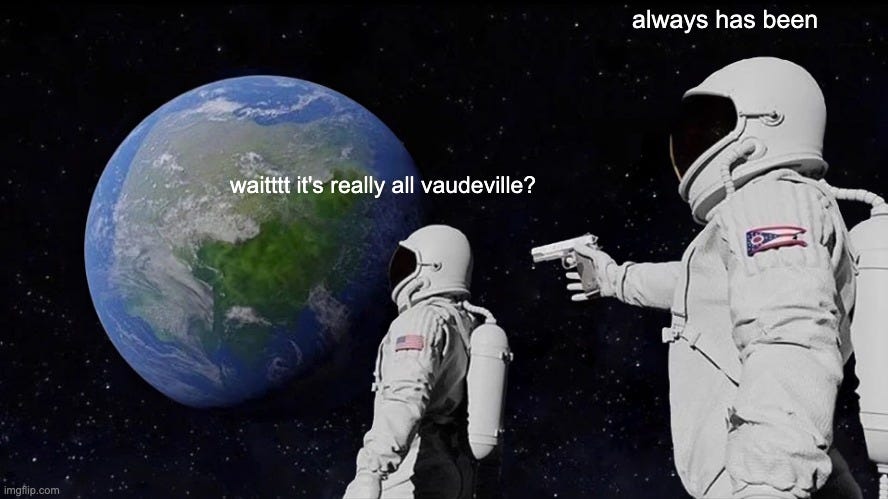
“There is nothing more important, although we’ve lost it, in our moment, than frivolity,” theater critic John Lahr, son of vaudevillian Bert Lahr, tells the camera in PBS’ documentary program Vaudeville: An American Masters Special (1997). “Frivolity is the species’ refusal to suffer.”
And oh, how our species is suffering. We’re cracking up, hardened to a point by the corrosive forces of banal cruelty, caught in one giant, ceaseless, stupid scam. It’s the Age of the Con, and the big wigs, too busy tearing everything down to bother to build anything for the future, are stripping the copper wiring out of the walls. It’s stunts, schemes, shenanigans, and stupidity until the bottom falls out. So why not meet the moment?
Welcome to April streaming.
In a key scene in Hannah and Her Sisters (1986), Woody Allen, that since-disgraced filmmaker once responsible for revitalizing the screwball comedy for the counterculture era, visits a movie theater in the wake of a suicidal episode, driven to desperation by his own existential ennui. There, he views the climax of Duck Soup (1933), the magnum opus of former vaudevillians the Marx Brothers, in which a quartet of troublemakers are leading the fictional country of Fredonia to war. The character is so moved by the hilarity of the antics onscreen that he forgets his woe and sinks into the comfort of the absurd. The Marx Brothers, like Allen, were the sons and grandsons, respectively, of Jewish immigrants, raised in New York City. They were key figures in a comedy continuum that extends back before vaudeville, to the legacy of Yiddish theater, in which traveling troupes entertained audiences with wit, irony, self-deprecation, and parody. This comedic sensibility, which lives on in ways we take for granted, was defined by strife and struggle and ostracization—how else to survive a hostile world than to laugh?
Farce will forever be relevant, as long as there are forces far outside our control, making life ridiculous—and ridiculously cruel.
It’s a mad, mad, mad, mad world out there, and this months’ programming is all screwy. Literally: we’re looking back at the screwball comedy, and the comedians of yore that made them so damn funny. Farce, pratfalls, slapstick, punning, shtick, and comedies of error—so, so much error—are the name of this month’s game. Plus: an actor who did the best Living Looney Tune to date, and a tribute to an actual Looney Tune. We’ve got a full bill—so stick around a while: if you don’t like what’s playing, just wait. You might enjoy what’s up next…
She Loves Me, I Could Tell Through that Screaming: The Screwball Comedy, a Primer

“Look I probably should have told you this before but you see...well...insanity runs in my family,” Cary Grant confesses to his new bride in Arsenic and Old Lace (1944), after having learned that his kindly, elderly aunts have been poisoning old men and burying them in their Brooklyn basement. “It practically gallops.”
It’s the perfect screwball scenario, epitomizing the elements that makes it run: a man, who until yesterday was just a run-of-the-mill, seemingly ordinary theater critic, cannot run off to Niagara Falls with his new bride because of circumstances beyond his control, like finding a dead body in the window seat. He cannot tell her, obviously, but he cannot leave with her until the situation is resolved. There’s no way out but through, as they say, as cock-eyed as the path may turn. Thankfully, for us, the viewers, the path turns outright screwy.
In the interwar period, when America was recovering from one war-to-end-all-wars and bracing for yet another one, a new micro-genre was born, engendered by the new technological possibilities of synchronized sound, which allowed for sharp, machine gun dialogue, and emboldened by the frenetic filmmaking pace of the Classic Hollywood era: the screwball comedy. It seems once the movies began “talking,” they wouldn’t shut the hell up! Shaking off the shackles of old Victorian-era social codes, these movies drew inspiration from the rapidly evolving dynamic between the sexes brought about by the Jazz Age: suddenly, men and women had newfound freedom to dance and romance, leading to a whole lot of fun—and creating a whole lot of obstacles before marriage tied them permanently to the the hearth.
The screwball comedy takes its name from a screwball pitch, which breaks in a different direction than the batter expects when it crosses home plate: wild and unexpected, the term connotes a tempo of comedy as much as a series of plot contrivances. A screwball comedy, loosely defined, is a comedy that relies on the ridiculous and absurd—misunderstandings, comedies of errors, desperate bids, harebrained schemes, and outrageous actions by erratic individuals—before the narrative plot can be resolved, generally in the form of a heterosexual union. There are many driving forces behind the absurdity at play in a screwball comedy—capitalism, usually: a couple cannot marry, or faces divorce, because there is no money, or they are mismatched across class, or disagree about money. Feminism, sometimes—a woman with a job, or newfound sexual freedom, cannot reconcile these gains with the potential for romance (and marriage). Typically, a woman’s headstrong nature or natural sense of independence interferes with her ability to perform the passive role expected of her as a courted individual. Other times, that stubborn will is directed steadfastly towards marriage, while her prey, the potential husband, runs firmly in the other direction (“Stand still, Godfrey, it'll all be over in a minute,” Carole Lombard tells a gobsmacked William Powell whiles standing at the altar in the final moments of My Man Godfrey, from 1936).1 Conflicting societal and familial expectations also often drive the screwball, such as the warring ideological battles between eccentrics and conservatives in Holiday (1938) or You Can’t Take It With You (1938). War, death, even the supernatural, can drive the bumpy, circuitous routes towards a happy end: in Topper (1937), an ever-bickering couple’s death and reanimation as ghosts interrupts their own love story; in To Be or Not to Be (1942), a couple’s fractured marriage is complicated by Hitler’s invasion of Poland; in I Married a Witch (1942), an American human man, well, marries a witch.
But ultimately, the driving force at the heart of every screwball comedy is modernity: the rapid, confusing pace of an evolving, increasingly mechanized world, which demands a new pace for every individual. Screwball women, unlike their demure, inhibited foremothers, are constantly in motion, playing out the “battle of the sexes” quite literally: in the iconic poster for Nothing Sacred (1937), Carole Lombard physically squares off against her lover, Frederic March (it totally makes sense in the context of the film, of course, because he’s actually trying to goad her into fighting him to raise her heart rate so she can convincingly pass for sick after conning all of New York into thinking she’s dying after he sold her fake sob story of radium poisoning in his newspaper in a desperate bid for readership…naturally).
A screwball comedy gets to the point of things: harried and manic in pace and structure, it mimics the feeling of post-industrial life, which chops all of us into mincemeat in its great, impersonal maw. But the screwball also finds thematic significance in the ultimately unknowable nature of life: all manner of conflict is, necessarily, resolved by film’s end, because of its open embrace of the absurd and eccentric, which supersedes considerations like class, sexuality, or gender. In Some Like it Hot (1959), Jack Lemmon, having spent the film in drag disguised as a female double bassist, confesses his real gender to an infatuated billionaire suitor, only for the man to shrug and concede, “Well, nobody’s perfect.”
It’s no surprise that the most beloved genre of classic film for young cinephiles is the screwball, which has an almost proto-Internet era comedic sensibility: these movies are fun. Consider Bringing Up Baby (1938): Cary Grant, a “straight man” pushed into the screwball mode by the outrageousness of his circumstances (the most satisfying of all transformations), is forced to answer the door in a fur-trimmed woman’s robe, to the shock of the person on the other side. Pressed for an explanation he jumps up, exclaiming, “I just went GAY all of a sudden!” It’s a moment that feels preternaturally engineered for our era: language evolves, our understanding of gender and sexuality evolves, but comedy of the absurd is timeless!
This program serves as a primer on the “screwball comedy,” from its early “talkie” origins to its pre- and postwar heyday, to the sex comedy spoofs of the 50s and 60s and postmodern pastiches of the 70s and 80s, all the way up to its ancestors in the 90s and aughts. It caps, fittingly, with Peter Bogdanovich’s Squirrels to Nuts, the “director’s cut” of his maligned screwball pastiche She's Funny That Way (2014), which screened in 2022 (to better reviews) after the late filmmaker’s death. Seeing as the director was one of the last intellectual ties to the titans of the classic screwball era, it’s a fitting way to go out.
Having ADHD (and being, let’s face it, a little dizzy myself), it sometimes feels like I’m a character in a screwball comedy (especially when I’ve had my cold brew!!). Sometimes, when my incredibly thoughtful but somewhat long-winded partner is explaining something oh-so painstakingly, and my attention is hanging on for dear life, I wish I could manually speed him up, just so I could absorb it all before the internal switch clicks and my mind has moved on, in search of a new anchor. I fantasize about moving through life like it’s fast-paced newsroom classic His Girl Friday (1940)—with its dialogue averaging a whopping 240 words-per-minute, against a general film average of about 140—our words overlapping in beautiful disharmony. Failure to adhere to this feverish pace would earn a crude “get on with it” gesture, like we’re hardened newspapermen chasing a deadline. In the forgiving landscape of the screwball comedy, that kind of antisocial (but ultimately humorous) gesture would be totally welcome.
“I suppose there is something cartoonish about me”: Bob Hoskins, the People’s Champeen

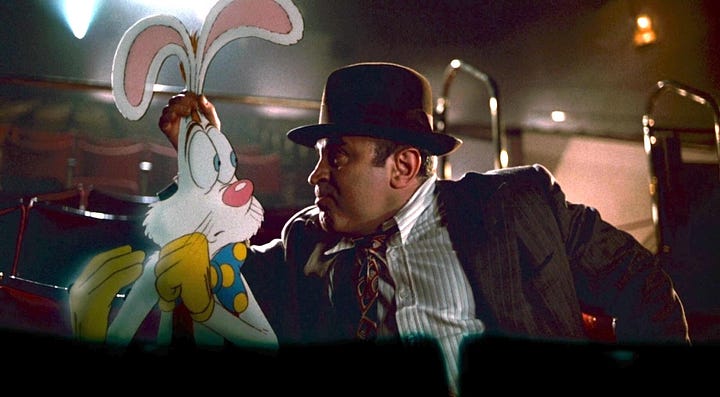
Bob Hoskins, beautiful lout that he was, was never supposed to be famous—nor, by any popular wisdom, a heartthrob.
“I came into this business uneducated, dyslexic, 5ft 6in, cubic, with a face like a squashed cabbage and they welcomed me with open arms,” he reportedly said in a 1988 interview, marveling at his own unlikely success in an industry that maintains a certain level of impossible beauty standards that should, by all rights, have precluded him from international, intergenerational fame. Frequently compared to his American counterpart Danny DeVito, Hoskins belongs to that particular category of actor who, because of his perceived unfuckability, should have been forever relegated to quirky character actor status. He is, to borrow a description used for another lauded character actor (and unlikely leading man) from the film Fargo (1996), “kinda funny lookin’.”
But I learned something about stardom, and sex, while watching his performance as an All-American, middle-aged shopkeeper who romances single mother Cher in Mermaids (1990), one of the great dramedies of its time. In fact, watching it one Sunday afternoon, three very different adult women, who agree on very little when it comes to men, swooned—outright swooned—over his confident seduction of a woman taller and (objectively) sexier than himself. I was one of those women; the attraction was totally sincere, and it was potent. In an era in which angry young men argue, loudly, that 80 percent of women are attracted to 20 percent of men, it’s beguiling to watch an “ugly” man cinematically seduce a woman through kindness, mutual respect, care for her children, and a healthy appreciation that he is batting way outside his league. Hoskins, a self-avowed feminist, claimed to have developed his skills as an actor watching women, and the way that women openly emote (with “an extraordinary clarity”) to learn how to properly showcase the emotions required of him as a performer. Was that the secret to his great success as a screen presence: he—to borrow a line spoken by another fat, balding heartthrob who deconstructed masculinity onscreen—had no interest in embodying the “strong, silent type?”
Much was once made of the “angry young man” archetype that came out of the British “kitchen sink” literary movement of the late 1950s, which explored the ennui of working-class men in a postwar landscape, channeled into films in what became the “British New Wave.” Codified by actors like Richard Burton, Albert Finney, Richard Harris, and Alan Bates, the “angry young man” served as stark counterpoint to the refined, erudite men of mainstream British cinema: an attempt to excavate the unseen, unseemly corners of (highly stratified) British life. Those actors grew up and out of that particular artistic era, which was largely transposed onto television, while British cinema returned to its predominantly aristocratic and/or commercial bent in the mid 1960s. But Bob Hoskins never grew out of his skint bent: despite requests that he take elocution and fencing lessons early in his career to mold him into a more generic—and palatable—English performer, he proudly maintained his thick Cockney accent; his natural strut; his edge. This imbued his characters with a certain underdog energy: even the ones that made it to the top of the heap felt like they had to claw and grind their way up there, always looking in from the outside, never quite reaching respectability, but always exuding authenticity. So when the time came for a real working-class bloke, as angry British cinema re-emerged towards the end of the century in ferocious defiance of Margaret Thatcher’s anti-arts agenda, he was primed to embody the moment. Which is maybe why every “edgy” UK actor since the 1990s (Tim Roth, Gary Oldman, David Thewlis, Stephen Graham, et. al) feels indebted to him. When Hoskins passed in 2014, The Observer questioned whether any working-class actor would again be given the same chances in a British film industry increasingly unreachable to those not born into the country’s wealthiest families.
Yes, despite his spookily proficient American accent, Bob Hoskins, like so many of our greatest stars, was Actually British: so British, in fact, that hearing him talk in his native accent can sound like listening to a parody of a British person. The son of laborers in Suffolk (“on the bum of the pig”), Bob Hoskins, to hear him tell it, became an actor totally by accident. While tending bar at a theater in 1968, “three parts pissed,” he was accidentally handed a script and found himself cast in the leading role. He began working in the theater in earnest, regularly appearing on the stage, and eventually on British television, breaking out—at age 36—on the highly-acclaimed (and deeply popular) Dennis Potter-penned series Pennies from Heaven (1978), which would later be turned into a Hollywood movie starring Steve Martin. A profoundly depressing exercise in misery, Pennies from Heaven casts the actor as an unhappily married traveling music sheet salesman living in the London suburbs during the global economic downtown of the 1930s; its central contrivance is that characters lip-sync to contemporary recordings of popular standards of the era, often in stark contrast to the misery of their situation. Hoskins’ character is just beastly: miserly and covetous, driven to ruin by the impossibility of his own dreams. But Hoskins, in playing him, is so compelling, you’re compulsively drawn to the character, endeared to his heartbreak despite his heinous behavior (something that, respectfully, doesn’t hold true for Steve Martin in the material’s Hollywood iteration). Hoskins could play the nastiest rat bastard with such conviction and nuance, you could always find some resonant part of the character to relate to: it was almost impossible to dislike him, or at least dismiss him outright. And when he played good guys, it was in no way contradictory to the arseholes he’d embodied previously. He flitted seamlessly between the two all his career, as easily as he switched up his accent:
Hoskins’ first major film role was in John Mackenzie’s classic The Long Good Friday (1980), playing an upwardly-mobile gangster conspiring with American mobsters to gentrify the London docklands in a desperate bid to legitimize his business. He’s mesmerizing, like a great predatory jungle cat prowling across the screen: all tightly-wound energy, simmering menace, and mounting desperation—a man on borrowed time, manifesting an Empire in decline. How can a man so small howl so ferociously?
He received his greatest acclaim, and an Academy Award nomination, for his painfully sensitive turn in Neil Jordan’s Mona Lisa (1986), a melancholy story of a crass, but ultimately kind-hearted, ex-con who, fresh out of prison and with few options available to him, begins shuttling a sex worker (Cathy Tyson) to and from jobs at the behest of an amoral crime lord (Michael Caine, at his most terrifying). The lonely pair develop an odd friendship, but it can’t withstand the strain of the transactional world they travel in, and the odd, sharp angles of the human heart. The Golden Globe winner and alleged favorite to win the Oscar that year, Hoskins lost in an upset to Paul Newman for The Color of Money (1986), though he walked off with the BAFTA and the Prix d'interprétation masculine at Cannes. He’d skillfully play a scheming, cash-starved Irishman playacting as an American entrepreneur to seduce a lonely religious spinster (Maggie Smith) in Jack Clayton’s maudlin The Lonely Passion of Judith Hearne (1987). And he made his directorial debut with the gender-bending anti-war film The Raggedy Rawney (1988), in which he plays the leader of a Romani caravan in World War II-torn Eastern Europe (he claimed to have Romani heritage through a grandparent) who takes in a doomed deserter (Dexter Fletcher) concealed as a mute spiritual woman.
But it was his next film that transformed him into a proper Hollywood star, and a pioneering screen performer in own right: playing the “straight man” and (live action counterpart) to a series of cartoon characters in Who Framed Roger Rabbit (1988),2 Robert Zemeckis’ groundbreaking hit hybrid film, which featured seamless, realistic-looking animation from cartoonist Richard Williams and helped revitalize Walt Disney Studios ahead of the so-called “Disney Renaissance” of the late 80s and 1990s after years of flops and failures. The meticulously-constructed film, a noir pastiche set in an alternate version of 1940s Hollywood in which humans and cartoons co-exist—necessitating extremely sophisticated, multi-layered character and background animation—only works because Hoskins plays it so seriously, allowing himself to be transformed, over the course of the film, into a living cartoon character, equally zany and irreverent. “I suppose there is something cartoonish about me, it’s what keeps me in work,” he remarked. “It’s my shape.” But what makes Hoskins so singular in the role is that he makes it all look so simple, when, really, it was quite a laborious process. The film, shot with a series of stand-ins, puppets, and mechanized systems simulating the cartoon characters’ “movements,” which animators then layered designs over, was estimated to have required about 15-45 takes per scene, with a team of creatives positioning and negotiating every single placement and movement, leaving its leading man covered in bruises. He developed his odd knack for convincingly interacting with sight-unseen cartoons through playing with his daughter and her imaginary friends, likening the acting process to an extended hallucination: “You gotta be able to bounce off the walls same as a cartoon.” The way he bounces in this, he may as well have been made of rubber.
Mermaids followed, as did Hook (1991), as did the (perfectly cast) lead role in infamous cult classic Super Mario Bros. (1993)—a film that the actor truly hated, claiming he was completely unaware it was based on a video game—and a slew of movies, some good, some bad, some big, some small, on both sides of the pond. Sometimes he’d play the rat bastard and sometimes he played a big softy; often, he played a combination of both, in compelling shades of grey. A proud lefty, he embodied a particularly swishy J. Edgar Hoover in Oliver Stone’s quietly brilliant conspiracy biopic Nixon (1995) and Nikita Khrushchev (!) in aughts war classic Enemy at the Gates (2001), a rare Hollywood dramatization of the Soviet role in World War II. He worked with lauded UK indie filmmaker Shane Meadows for two acclaimed works inspired by the filmmaker’s own childhood: boxing film Twenty Four Seven (1997) and coming-of-age classic A Room for Romeo Brass (1999). He led Mom Cinema Classic Mrs. Henderson Presents (2005), about a girlie show run by Judi Dench against the backdrop of the Blitz. He played, with terrifying intensity, legendary MGM publicity “fixer” Eddie Mannix in Hollywoodland (2006)—a dramatization of the infamous, incredibly suspicious “suicide” of first Superman actor George Reeves (Ben Affleck), which Mannix likely orchestrated and concealed using his Hollywood connections after the man broke off an affair with his swinger wife—and a seedy patron known only as “The Baron” in Abel Ferrera’s cult strip club movie Go Go Tales (2007). He even showed up on Frasier in 2003, playing a bullying childhood gym coach that Frasier can’t help but map on to a new girlfriend who is a P.E. instructor, seeing him in her place. These characters, so vastly different, all feel completely authentic and wholly realized, despite Hoskins’ famous face and gruff, accented voice. Whether he’s being good or (very) bad, or some creature in between, British or American, a gangster or a laymen, when you see his name in the credits, you know you’re about to see some real fucking acting.
Kid, You've Gotta Get a Gimmick: the Legacy of Vaudeville
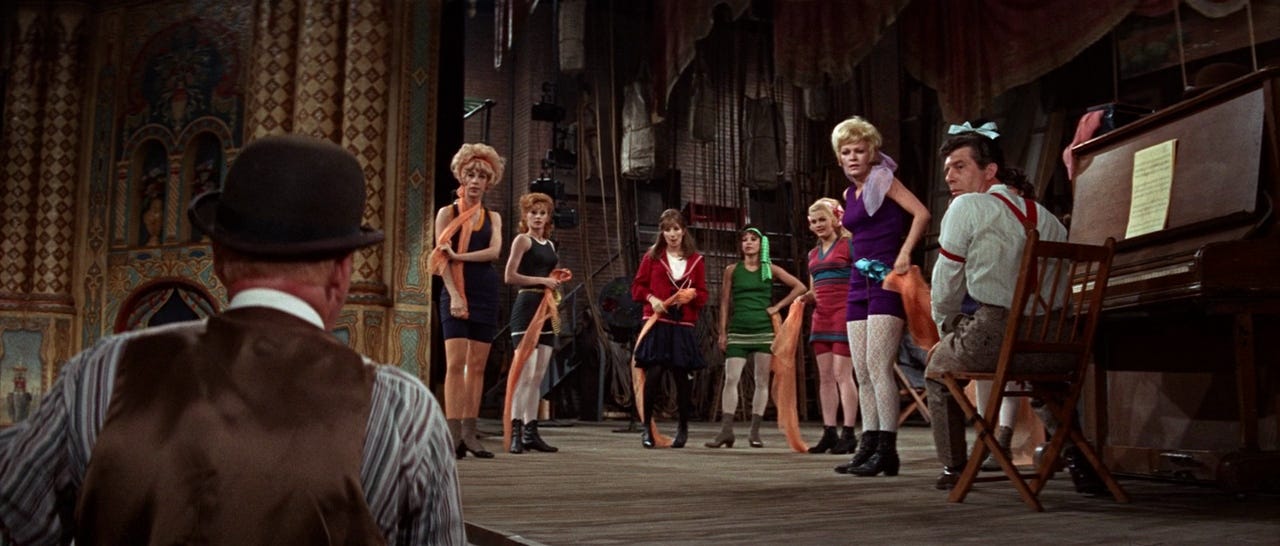
“It's all in the game and the way you play it / And you've got to play the game you know / when you're born in a trunk at the Princess Theatre / in Pocatello, Idaho,” Judy Garland sings in “Born in a Trunk,” the musical centerpiece of the film-within-a-film of A Star is Born (1954), her Hollywood comeback vehicle following years of professional and personal setbacks. Garland, the greatest musical star to ever grace the silver screen, may as well have been singing her own biography: born to two vaudevillians, she first took the stage at the tender age of two, performing ditties alongside her two elder sisters. The trio later toured the vaudeville circuit as “the Gumm Sisters” in an era in which extremely localized child labor laws, if they existed, were routinely broken by juvenile performers.3 There’s no hope for a secular life, “Born in a Trunk,” suggests, when show business is all you know; for Garland, the exacting, all-encompassing life of a vaudevillian first prepared her to be a movie star.
Vaudeville, a late 19th-century cultural force that pre-dated—and was ultimately destroyed by—the advent and rise of commercial film, was a form of theatrical entertainment we might commonly understand nowadays as the “variety show”: several “acts,” programmed on a single bill, that played to live audiences for very low prices. Born out of several live theatrical traditions at the turn of the century—English music hall,4 P. T. Barnum’s freak “museums,” minstrel shows, and Yiddish theater—vaudeville, or “the business,” as it was known to those who toiled within it, entertained a populace liberated by newfound gains in labor, as reduced work hours gave rise to the concept of “recreational time.” Roughly stretching from the 1880s-1930s, the story of vaudeville is one of urban growth and decay, immigration and assimilation, and class. Though its roots preceded the American experiment,5 it is, inherently, an American story. Showmen and women (and children), many of them immigrants or children of immigrants, toured “circuits,” or clusters of theaters on routes across the United States, long before cinema (and radio, then television) cannibalized “the business” as a specific art form. They played to diverse audiences, many of whom were immigrants themselves, who saw themselves, for the first time, reflected back in the popular entertainment of their new home country. Though we might not think much of it now, vaudeville transformed popular entertainment, cultivated the talent pool for mass media, and built the foundation of modern comedy. There would be no film (or comedy) culture without vaudeville culture; it’s like trying to hatch a chicken without an egg.
When the Cowardly Lion mugs and shadowboxes while goading, “Put ‘em up, put ‘em upppp” in The Wizard of Oz (1939), that’s a bit actor Bert Lahr first developed during his time on vaudeville, reworking his own popular stage shtick—meaning a routine; a gag; a bit—in which he’d muck about as a hapless policeman. When the Three Stooges jabber on in “gibberish” noises between slapping each other silly in their beloved short films, they’re actually incorporating Yiddish and slapstick, a conceit born out of the original vaudevillian iteration of the group with Ted Healy (a “stooge,” in vaudeville, referred to someone in the audience who gets “pulled” into being in an act). When Cary Grant pratfalls and handstands in Holiday (1938), he’s utilizing the skills he developed as a teen in a vaudevillian acrobatic group, the “Pender Troupe.” Escape artist Harry Houdini, who first drew national attention for his vaudeville stage disappearing act, took his antics to film in the 1910s, becoming an innovative early film stunt performer. Gertie the Dinosaur (1914), a pioneering work of early animation that’s the best surviving film of New York Harold cartoonist Winsor McCay, was actually developed out of the animator’s stage act, a “chalk talk,” in which which he drew crude animations of simple character actions onstage before audiences. The Nicholas Brothers, whose cultural legacy cannot be overstated, found tremendous success as children in vaudeville, where they performed song and dance duets as “the Nicholas Kids,” though their cinematic output remained frustratingly limited (though no less revelatory), owing to era racism and their refusal to adhere to minstrel codes of performance that governed film culture (and most of vaudeville as well). Buster Keaton, Charlie Chaplin, Mae West, W.C. Fields, Jack Benny, James Cagney, Bob Hope, George Burns and Gracie Allen, the Marx Brothers, Fanny Brice, Jackie Gleason, Abbott and Costello, Red Skelton, Fred Astaire, Ginger Rogers, Cab Calloway, Eddie Cantor, Milton Berle, The Three Stooges, Moms Mabley, Jimmy Durante, Ethel Merman, Stan Laurel, Oliver Hardy, Ethel Waters, Zero Mostel, Burt Lancaster, Will Rogers, Danny Kaye…all these titans of American popular entertainment were former vaudevillians, many first developing the “shtick” that would follow them into stardom while treading the boards before effusive live crowds. So many more didn’t make it…countless names, forgotten by the sands of time.
As someone who has always loved comedy and live performance, possessing talent in neither, I’ve always held a special affinity for vaudeville—where a lack of talent wasn’t a hindrance to finding success. The secret to vaudeville’s popularity was in its brisk pace, varied structure, and seemingly endless wellspring of performers. Bills typically consisted of 5-20 acts, programmed strategically to coincide with the comings-and-goings of theatergoers: the lousiest went first and last, when the audience was filing in and out; “blue material”6 was strictly forbidden, owing to the family crowds; and “amateur nights” were thrown as a popular, cheap form of drawing bodies and poaching talent—allegedly, the concept of a performer getting dragged offstage by a giant hook comes from a former Bowery theater, which used the gag for laughs on amateur nights. A 1914 “How to Enter Vaudeville” handbook, cited in a 1997 PBS television documentary, gives the following examples as potential vaudeville acts:
Shadowists, bird imitators, handcuff chain & trunk acts, chapeaugraphy,7 lightening calculators, equilibrists, clay modelers, fancy divers & swimmers, living picture models, statuary posing, paper tearing, whistlers, billiardists, hypnotic acts, contortionists, eccentric acts, hobo acts, comedy cartoonists, “Ethiopia entertainers,”8 feats of strength, electrical acts, knockabout acts, Risley artists,9 iron jaw acts, cornetists, gun spinners, trick pianists, rolling globe acts, tabloid plays, novelty ladder acts, parody singers, yodelers, [and] mind reading…
Circuits ran the gamut from small time—which could be anything from converted storefronts in podunk towns to pitched tent shows—to big time, with top headliners playing opulent theater houses, the biggest of which was the acclaimed Palace Theater in New York (now the site of the TKTS kiosk in Times Square). If you reached the Palace, you’d “made it,” affording you a chance at further upward mobility. This created several “rungs” of theatrical show business by the 20th century, all of which had their own codes, requirements, and style. At the bottom was burlesque,10 a form of artistic caricature, which, like vaudeville, dated back to the Victorian era; unlike vaudeville, burlesque was bawdy and blue, existing primarily as a space for beautiful young women to strip, though their routines were broken up by comedic acts (“burlesque comics”), many of whom performed in vaudeville as well. A rung above vaudeville was the “Ziegfeld Follies,” a form of theatrical musical revues designed and mounted by Florenz Ziegfeld Jr., who made many a young starlet out of a comely chorus girl. Inspired by the Folies Bergère of Paris, Follies mostly existed as a showcase for beautiful women to strut across the stage in opulent designs, though it also employed musical performers and comics of both genders like Fanny Brice, W.C. Fields, and Eddie Cantor. Finally, there were proper Broadway book musicals (what we associate Broadway with almost exclusively today); with the popularization of synchronized sound in the late 1920s, many stage stars were funneled directly to Hollywood to appear in early sound musicals, like (of course) The Jazz Singer (1927), a showcase for vaudevillian Al Jolson’s popular minstrel act (done in blackface), and The Broadway Melody (1929). There’s an easy way to keep this all straight: someone already did the hard work for us. In the film-within-a-film made in Singin’ In the Rain (1952), itself a reworking of early sound musicals set during the advent of synchronized sound cinema in the 1920s, Gene Kelly pitches the “Broadway Melody” musical sequence: a character backstory that demonstrates one man’s rise from job-seeking nobody to Broadway star, all within a matter of minutes (using the same “Broadway Rhythm” musical motif):
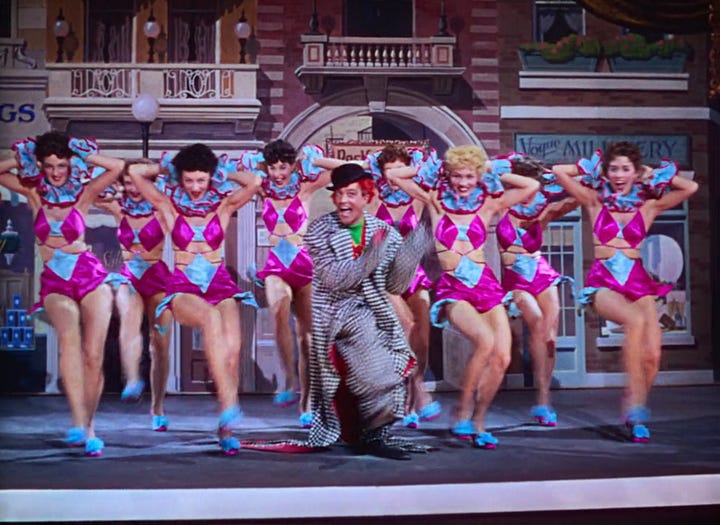

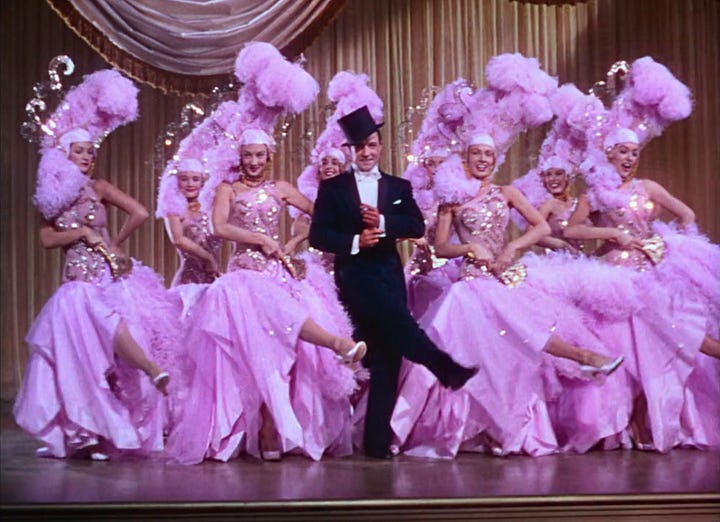
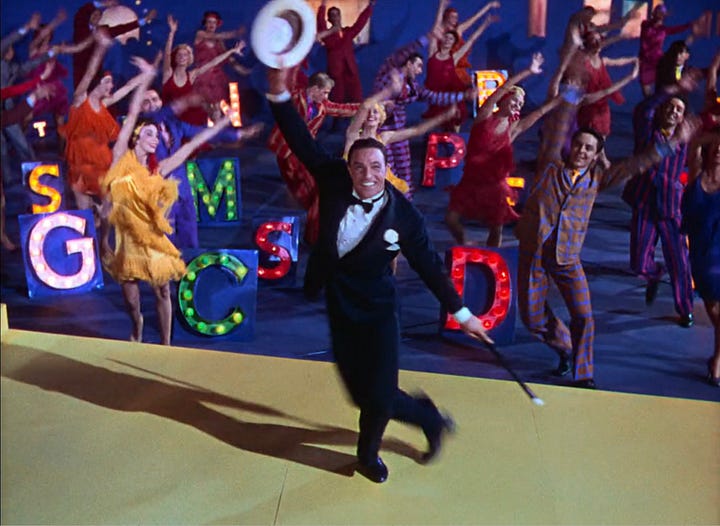
You can see how an ecosystem begins to form from all of this, though it was hardly a straightforward or streamlined process: vaudeville-style performance mixed with other forms of live entertainment, including circus acts and freak shows, and vaudeville and early film exhibition actually cohabited the same space for many years, in “combination” or “presentation” houses, which showed mixed bills of film exhibitions and live performances, used as “coolers” to give projectionists time to change reels. In Busby Berkeley’s Footlight Parade (1933), for example, James Cagney (a former “hoofer”) develops elaborate “movie prologues,” or vaudeville-style musical comedy acts to perform in between films. Many vaudevillians like Rudy Vallée and Milton Berle went into commercial radio, popularized in the 1920s, the first real existential threat to live performance because it kept potential audiences at home, tethered to their sets. Radio became television, with many of its biggest (and most influential) stars hailing from the vaudeville circuit and forever shaping the style of comedy on the medium). In fact, the very foundation of early television—with its variety format and “master of ceremonies”-style figureheads, who’d morph into late night idols—is indebted to the structure and tempo of vaudeville.
This program offers just a sampling of the creative influence wrought by vaudeville’s incredible legacy—films and television shows that feature the work of vaudevillian artists, as well as movies about vaudeville. It includes the tangential world of burlesque and the advent of the striptease, from the mainstream success of Gypsy Rose Lee all the way up through the “pin up” culture of the 1950s, which made a multi-generational star out of Bettie Page and continues to influence showgirls and practitioners of “nu-burlesque” well into our current moment. It also includes the shameful legacy of the “minstrel show,” and vaudeville’s penchant for exaggerated ethnic and racial pantomime, reflective of the cultural tastes of its era. In vaudeville, which branched out from the traveling minstrel show—an enduring cultural artifact that dated back to the early 19th century, before the Civil War—blackface was readily employed by both white and black performers. In fact, most black comedic vaudevillians use dark face paint (either greasepaint or burnt cork) in the service of their comedic performances to convey racial stereotypes about dark-skinned black people as inherently lazy, stupid, and duplicitous, even before black audiences. This leaves behind a thorny, little-known legacy of early black performing pioneers, like Bert Williams—one of the biggest stars of his day and one of the first black leading men on Broadway—whose few surviving films capture his incredibly popular stage act and showcase the performer in his signature dark facial makeup. Despite these fraught legacies, vaudeville was actually quite diverse, and performers had a certain level of personal control over their own acts. The mass media that replaced vaudeville was less kind to performers of color: those rarefied few who did manage to crossover into film and early television were forced to almost exclusively embody minstrel-show racial stereotypes, which is why so many roles in Classic Hollywood filled by black Americans were so-called “Stepin Fetchit” parts, so named for the vaudevillian-turned film star who played a lazy, stupid stereotype at the behest of white creatives.
Our history is defined by such frustrating contradictions and moral quandaries; excavating history requires a certain amount of reckoning with the powerful forces of hate that shaped our past in every possible sense. As much as theatrical histories can feel hopelessly complex, dense, and out-of-reach to our eyes beyond the traces left behind on recorded mediums, our greater understanding of such historical nuances helps us understand film history, American culture, and the cult of celebrity better. Vaudeville was once such a popular form of entertainment that real-life notable figures took stints traveling the circuit in a desperate bid for guap, including, believe it or not, people like Babe Ruth, Jack Johnson, and Helen Keller. Vaudeville was a wild, messy, and intensely democratic institution—down to the hecklers in the audience, who would make it immediately, loudly known if material wasn’t up to snuff.
Honestly, I could talk forever about vaudeville, and this might actually be one of my favorite programs I’ve ever done: peeling back each layer of cinema history just revealed more and more fascinating connections to the “business.” So greedily did I gorge myself on vaudevillian history, and how much it informs our present, that it consumed my thoughts for weeks on end. By the end of it, I had my own vaudeville act all planned out: the perfect routine to be performed in the middle of Toledo with nothing but a suitcase and a choppy bob to my name. It’s a husband-and-wife act, a so-called “Dumb Dora” bit, in which I played the part of the mindless, dizzy dame, unaware of the chaos I’d engender on my poor, long-suffering partner. I’d dutifully lay out obstacles for my husband in the guise of being a helpful, thoughtful wife: like placing shoes out that he’d then proceed to trip over, tumbling across the stage, or loosening the cap on a bottle of orange juice I’d hand over, which he’d then unknowingly shake, sending liquid everywhere…bits inspired by the chaos of real life, made hilarious in pantomime. It’s the one thing about show business that will never change, not really, stretching all the way to our current moment, in which internet pranks, challenges, irreverence, and instant gratification evoke the qualities of a bygone, mostly forgotten era more than we realize: “Kid, you've gotta get a gimmick, if you want to get ahead!”
What’s Who’s Up Doc: in the Shadow of Bugs Bunny
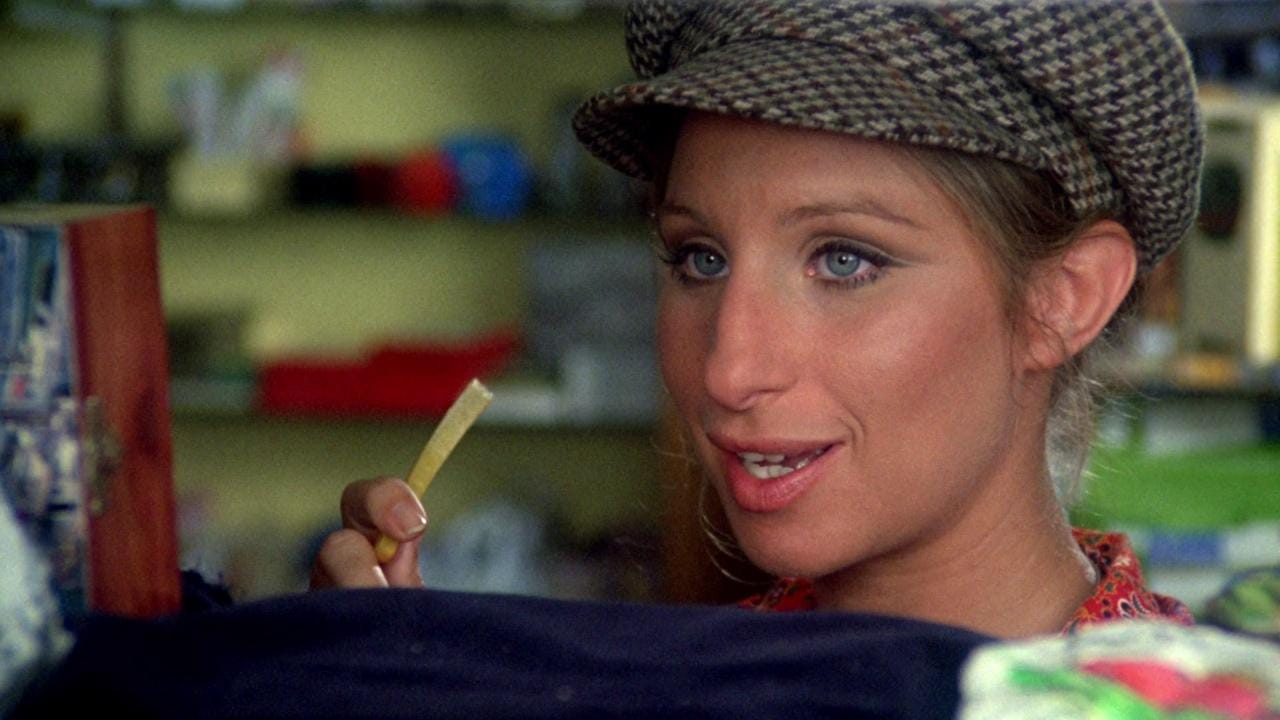
When Christopher Walken recently disclosed that he’d secretly played several roles throughout his illustrious career “as” Bugs Bunny, “one of his favorite actors ever,” it fueled speculation as to what, exactly he meant (as well as which films could credibly reflect this bold claim). But anyone familiar with Walken’s fluid physicality and distinctly New York sensibility understood what he was getting at: Bugs Bunny, that ultimate showman, is the heart of American popular culture and a particular source of inspiration for many performers. Cool, calculating, performative, wisecracking, showboating Bugs: a wiseguy; a con man; an anarchist! But always the good guy. When Bugs looks directly to the “camera” and gestures back derisively at whatever’s going on the scene, taking us into his confidence, it’s like we’re right there in the world with him, laughing, just out of frame. “He’s so smart, he’s so funny, he’s got such a great attitude,” Walken previously gushed in a 2001 interview to the Washington Post. “Bugs Bunny is the spirit of New York…He’s on to everybody.”
Who doesn’t love Bugs Bunny? Apparently, David Zaslav, CEO of Warner Bros. Discovery, and proprietor of Warner Bros. entities, which includes the Looney Tunes: in an act of artistic villainy so cartoonishly evil, it’s the actual plot of Space Jam: A New Legacy (2021), Warner Bros. Discovery recently erased the classic Looney Tunes shorts from their increasingly malnourished streaming service, Max, to universal jeers in the proverbial town square. Boo this man! Cue the tomatoes! But Bugs’ impact is wide-reaching and everlasting: his celebrity will long outlast the negligent guardians of his name, even if it gets a little harder for all of us to watch his antics.
The brainchild of a team of animators working at Leon Schlesinger studios (which became Warner Bros. Cartoons) in the 1930s, and the single most significant byproduct of the Golden Age of Animation (eat shit Mickey Mouse!), an early prototype of Bugs first appeared in the short film Porky's Hare Hunt (1938), though he’d officially make his debut in Tex Avery’s A Wild Hare (1940). A humorous trickster who refused to say uncle, Bugs became the preeminent star of the Looney Tunes and Merrie Melodies series of animated short films, which played before feature films on multi-bill programs (a variety format that, you guessed it, mimicked vaudeville). He appeared in 160 short films before garnering his own primetime television program in 1960, The Bugs Bunny Show, which ran in syndication for years (including well into my own childhood in the 1990s). Voice actor Mel Blanc—the “The Man of Thousand Voices” and memorable, original voice of Bugs Bunny—first got his start on, you guessed it, the vaudeville circuit, performing shtick music, gifting Bugs his distinct New York accent, theatricality, and streetwise sensibility. Blanc’s ridiculous vocal range, a major boon to Bugs enduring likability, regularly produced sounds that should not be humanly possible, all in the service of a laugh:
There are a number of performers and filmmakers who have been influenced by Bugs’ attitude, outrageousness, sticky and nebulous gender presentation, and all-encompassing sexuality. Bugs, a “boy” bunny who does not wear pants, had an iconic penchant for dressing up as beautiful, beguiling women with ample breasts (crossdressing: a staple of vaudevillian humor), seducing the very masculine foes who just loved to chase him around. “Did you ever find Bugs Bunny attractive when he put on a dress and played a girl bunny?” Garth (Dana Carvey) famously asks his best friend, Wayne (Mike Myers) in Wayne’s World (1992), to his friend’s derisive laughter. “Neither did I. I was just asking.”
This program collects a too-brief sampling of performances—by men and women—that exude Bugs Bunny Energy, including the feature film appearances of the character himself over the years (you’d be surprised at some of the places he winds up!). It starts with the character’s clear cinematic inspirations—the freewheeling antics of Groucho Marx, the animated grace of Douglas Fairbanks, and the wisecracking wit of Clark Gable in It Happened One Night (1934)—and spans all the way up to the Walken of it All. From the fluidity of Jackie Chan—whose tremendous grace and time studying in the Peking opera, where men played female roles, well-prepared him to embody the spirit of Bugs onscreen—to the malleable mugs of Donald O’Connor, Jim Carrey, and Jerry Lewis—to the world-weary insouciance of Jean Arthur and Natasha Lyonne…here’s to the Bugs of it all, long may he (and his chaos) reign. Happy Easter!
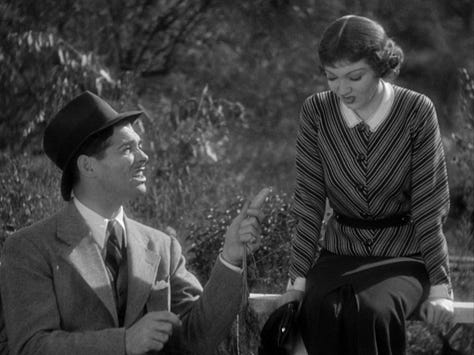


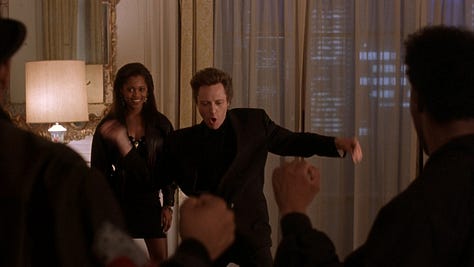
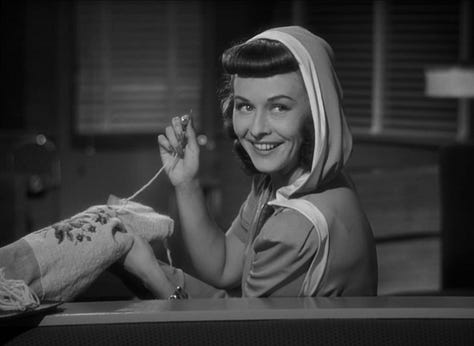


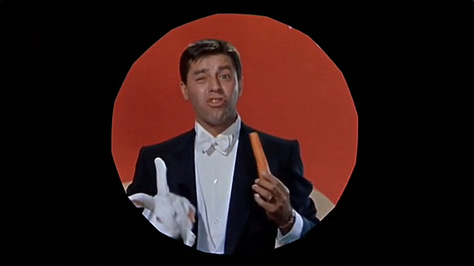
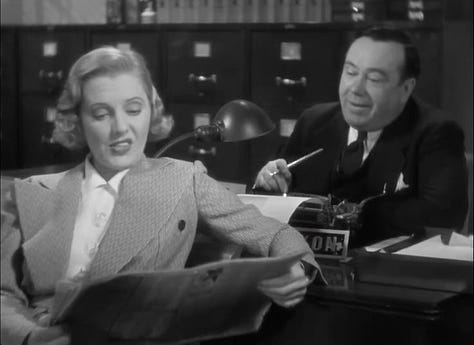
That’s all folks it for April! Until our paths meet again…“I’ve stuffed the dailies in my shoes / strummed ukuleles / sung the blues / seen all my dreams disappear…but I'm here…”
Ironically the screen pair, formerly married in real life, had been divorced for three years when they made this movie.
Bit of Spread-centric lore here but the movie’s original screen test, which so impressed executives it convinced them to invest solely needed capital into the fledgling project, stars none other than Joey Pants!
Perhaps most infamously by the family of silent film/comedy pioneer Buster Keaton, who appeared, beginning at age three, in the family act “The Three Keatons.” His role was to be a living prop (and projectile): his father, as a form of “discipline,” would throw him across and around the theater as hard as he could, just to prove he could get back up again totally unscathed.
If you’ve ever wondered why the men of Monty Python so relished the opportunity to dress up as women, it’s because crossdressing is a longstanding British cultural tradition tied to pantomime, an English-specific form of interactive theater that dates back centuries, born out of commedia dell'arte. The so-called “pantomime dame,” or a male comedian dressed as a matronly woman, was an important fixture of English music hall, a variety-show format that was popular from the Victorian era up through World War I.
As Ben Vereen narrates in Vaudeville: An American Masters Special (1997): “Street performers, jesters, clowns, yiddish Broderzingers, and commedia dell'arte players, they were the first vaudevillians.”
The use of “blue” to describe explicit material derives from the blue-tinted envelopes used by managers of the Keith-Albee vaudeville circuit, which would detail all the material deemed inappropriate for audiences in each act.
Wayne Keyser, author of carnival history podcast Ballycast describes this as: “An act in which the performer uses a large stiffened circle of felt with a hole in the center to bend and twist into various hats, depicting various characters.”
As far as I can tell, this means performers in blackface.
That’s the circus act where the performer lies on his back and rolls things with his feet, so-named for circus performer Richard Risley Carlisle.
Burlesque circuits featured women stripping to audiences of adult men and—unlike family-friendly vaudeville—it was considered quite déclassé (and was cheaper to attend). It also included live comedy acts between numbers: performers like Phil Silvers, Zero Mostel, Jules Munshin, Red Buttons, Red Skelton, and Abbott and Costello all performed in burlesque. The modern “striptease” was allegedly birthed at Minsky’s, a popular brand of burlesque theaters that operated out of New York City in the early 20th century. Despite being relatively tame compared to modern stripping, Minsky’s continually pushed the button of what was legal for public performances at the time, encouraging their performers to go topless, which led to police raids as early as 1917. According to lore, the modern striptease stems from a Minsky’s performer “accidentally” revealing skin to the audience while flying towards the wings of the stage; she then began stripping in earnest at the audience’s enthusiastic reaction. Mayor Fiorello La Guardia's crusading administration revoked Minsky's license (and refused to issue additional ones) following a 1937 raid (after a dancer was spotted performing without a G-string), which effectively ended burlesque in the city.



